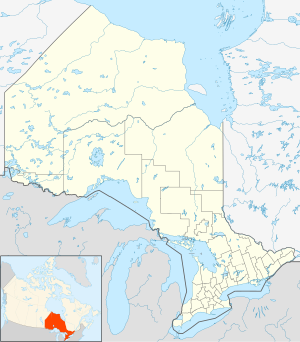CFS Armstrong
This article needs additional citations for verification. (December 2012) |
| Canadian Forces Station Armstrong | |
|---|---|
 | |
| Coordinates | 50°18′19″N 089°00′49″W / 50.30528°N 89.01361°W |
| Type | Radar Station |
| Code | C-15 |
| Site information | |
| Controlled by | |
| Site history | |
| Built | 1952 |
| Built by | |
| In use | 1954-1962,1962-1974 |
- For the civil airport, see Armstrong Airport
Canadian Forces Station Armstrong (ADC ID: C-15) is a former General Surveillance Radar station. It is located 1.1 miles (1.8 km) east of Armstrong, Thunder Bay District, Ontario. It was closed in 1974.
It was operated as part of the Pinetree Line network controlled by NORAD.
History
Origins
There was military activity in Armstrong during the
Cold War
As a result of the Cold War and with the expansion of a North American continental air defence system, Armstrong was selected as a site for a United States Air Force (USAF) radar station, one of the many that would make up the Pinetree Line of Ground-Control Intercept (GCI) radar sites.
This second period began with construction starting in 1952 and completed in 1954. The site was originally known as Armstrong Air Station in the early 1950s and it was home to the USAF's
As a GCI base, the 914th's role was to guide interceptor aircraft toward unidentified intruders picked up on the unit's radar scopes. These interceptors were based at the
On 1 April 1963 Armstrong AS was connected to the
Later that month, the American station was handed over to the
- Search Radar: AN/FPS-27
- Height Radar: AN/TPS-502, AN/FPS-26
Popular by virtue of being the only radio station, CFAO began broadcasting from the trailer court on the station in the early 60's with a 10 watt transmitter. It was run by a core of 20 volunteers offering music and news to the station and surrounding area seven days a week on 1450 kHz. Armstrong had up to three deHavilland Canada Otters operating from the DOT run airfield at any one time. The Otter Flight's duties ranged from logistical support, search and rescue, to "Flying Doctor" services. The "Flying Doctor" service was offered on a weekly and monthly basis to personnel stationed at Pagwa and Sioux Lookout. Medical evacuations were carried out as necessary. Dental services were provided on a bi-monthly visit by a Royal Canadian Army Dental Corps detachment. The station had limited recreational facilities, so hunting and fishing became quite popular, as did snowmobiling.
With unification of the
Later that year the site was sold to private owners and became into a popular gathering area for Armstrong residents. The site included a restaurant and bar, hotel, multiple apartments, garages, and a curling rink. The area, known as D&L, was closed in 1993 and remains abandoned behind the main gate. There is much to see for the ghost town hunter as all but a few buildings remain. A few Radar towers are standing and the airfield is now run by the provincial government.
See also
- List of Royal Canadian Air Force stations
- List of USAF Aerospace Defense Command General Surveillance Radar Stations
References
![]() This article incorporates public domain material from the Air Force Historical Research Agency
This article incorporates public domain material from the Air Force Historical Research Agency
- ^ Dziuban, Stanley W. (1970). Military Relations Between the United States and Canada 1939 - 1945. United States Army Center of Military History. p. 196. CMH Pub 11-5. Retrieved 2010-06-30.
- ^ a b c Cornett & Johnson, p. 104
- Cornett, Lloyd H; Johnson, Mildred W (1980). A Handbook of Aerospace Defense Organization, 1946 - 1980 (PDF). Peterson AFB, CO: Office of History, Aerospace Defense Center. Archived from the original (PDF) on 2016-02-13. Retrieved 2011-11-29.
- Ozorak, Paul. Abandoned Military Installations of Canada: Volume I: Ontario. 1991. ISBN 0-9695127-1-6.
- Winkler, David F.; Webster, Julie L (1997). Searching the skies : the legacy of the United States Cold War Defense Radar Program. Champaign, IL: US Army Construction Engineering Research Laboratories. ]
- Information for Armstrong AS, ON

